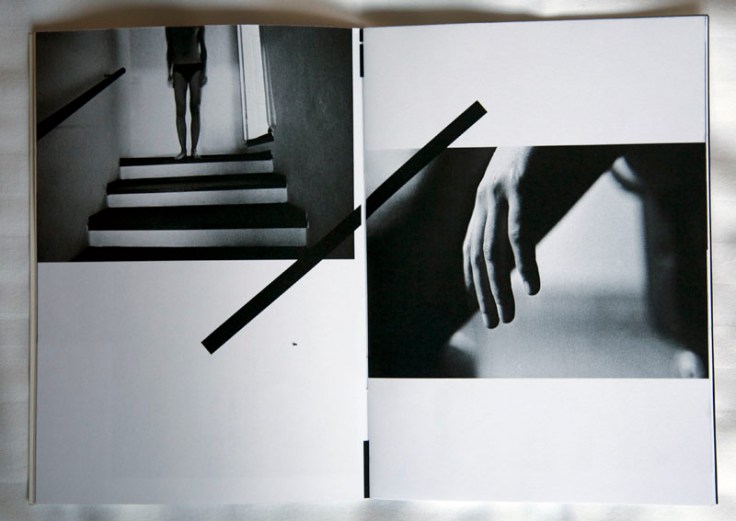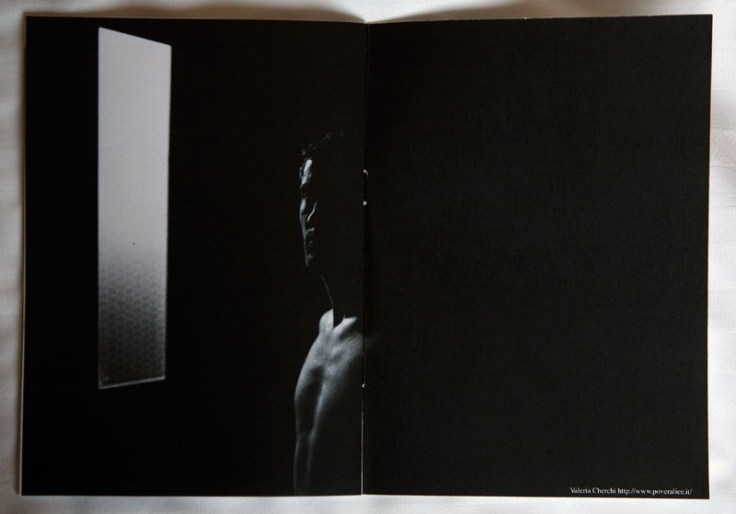Copyright 2010 Valeria Cherchi courtesy AAlphabet Libri
Valeria Cherchi is providing a short and relatively dark narrative about a house that is inhabited by two individuals who do not appear to be connecting with each other. Her two subjects for this photobook are a young man and a young woman and the building tension between the two of them.
The man is photographed alone, either sitting or standing with a vacant expression and in one photograph has his bowed down. The woman in turn is also photographed alone, alternating between an upwards glace or with her bowed. Both individuals appear to be waiting, in contemplation as though anticipating for the other’s initiating advance. The woman appears in a dreamlike state, as though embracing and in a dance with her lover, with someone who is not there. The bed is entirely hers, whether by default or plan, nevertheless, creating a sense of loneliness and sadness.
The last photograph of the book spans the two page spread and is printed full bleed. The man continues to stands alone, now in a three-quarter profile, shrouded in the semi-darkness, his profile lost the in deep shadows. It is a stark, graphic, haunting, and eerie photograph. There is an illuminating window pane just behind him and it appears to be part of a door. This dark image of the shirtless man creates an ominous and foreboding feeling of an implied threat to who may be just beyond the other side of this door. What I might call an Alfred Hitchcock moment.
Cherchi’s black and white photographs are stark, tightly framed and border on being minimalistic. With a minimum of content, it can allow the reader more freedom to fill in the unanswered spaces. The minimal clothing of both individuals implies the appearance of vulnerability and accessibility that perhaps they have nothing to hide between themselves. Yet they do not appear together in any of the photographs and at best, are in separate photographs on facing pages, with the implied dialog crossing the binding of the book, as though the binding is a silent and imaginary barrier between the two.
Situated between the photographs are graphic symbols, the meaning of which is codified and ambiguous to the reader. The layout of the photographs mixed with the graphic elements is a bit confusing. After a number of readings, I am still not sure if the graphic elements and symbols are helping or distracting this narrative. These graphic elements are printed a very solid and dense black relative to the photographs and they seem to act as anchors that pull the focus away from the photographs. The graphics create a sense of tension that somehow then resonates in the photographs.
I found Cherchi’s cinematic narrative to be fragmented, erratic and difficult to follow, but with a captivating ending. Nevertheless, Cherchi and her publisher should be lauded for investigating an experimental layout with the inclusion of different graphic elements (alternatives to text) to structure a different photobook concept.
This photobook is printed in one color with the text in Italian, but my copy came with an insert that contained both the original Italian and an English Translation. I am not very sure (as my Italian is very limited), but appears that the English translation is a bit on the rough side.
by Douglas Stockdale






Very interesting book. Thanks for posting
If ever there was a great example of the best use of the double page spread, this is it. I love the way this book’s been laid out. It’s bringing greater to meaning to images and allows the reader to experience the images in sequence. This is a great lesson for anyone looking to create successful photo books, so thank you for sharing this.